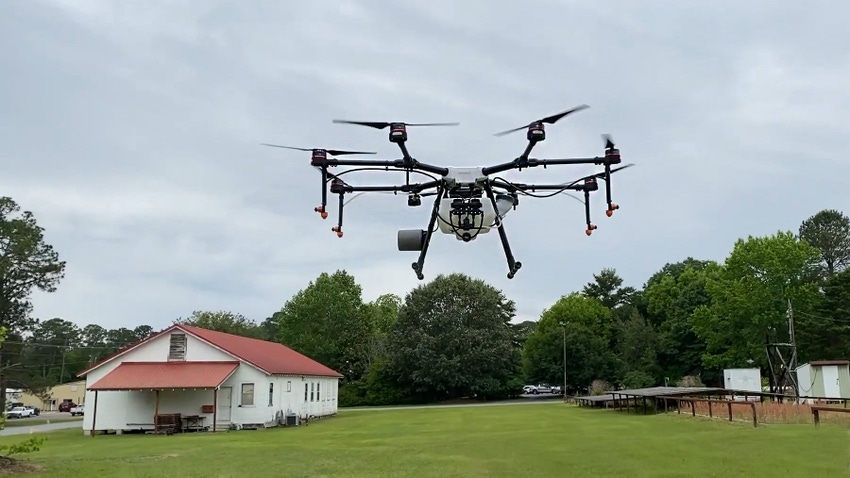
Matthew Ashcroft has seen the future.
“This is it; this is the future,” says Ashcroft, who refers to himself as a crop duster transitioning to unmanned aerial vehicles in the near future.
Ashcroft, owner of Aerial Ag Services, Hill County, Texas, discussed UAV technology during the opening session of the Texas Plant Protection Association’s 35th annual conference Dec. 5 in Bryan.
“I started last year with a drone manufactured in China,” he said. That unit ended up in the dustbin following an unfortunate encounter with a guy wire supporting a cell tower. He plans to replace that one with a Hylio drone, manufactured in Texas. “I want to deal with a company that provides service and will communicate with me in English,” he said.
Last year’s experience offered insights into advantages and limitations that drones bring to aerial applications.
Ashcroft said drones improve application safety since unmanned vehicles do not put a pilot in jeopardy.
Other drone advantages include:
Impervious to adverse soil conditions
No soil compaction
They are quiet and remain in the field. “No complaints about flyovers.”
Less expensive than aircraft and large ground spray rigs
Improved spray accuracy. “Practically no overspray or streaks.”
Precision application
Ashcroft said drones currently provide precision spraying with herbicides, fungicides, and insecticides, and can operate in congested areas.
They also offer field management services such as crop monitoring, soil assessments, evaluating irrigation and drainage, crop protection, and surveying.
He concedes that drone use comes with a few limitations. “We have short flight times because of battery capacity, and hoppers are relatively small.”
He said a critical limitation is line of sight requirements. Drone operators must maintain line of sight, according to FAA restrictions. “And obstacle avoidance systems have much room for improvement.” He said the crash that doomed the drone last year could have been averted with a better obstacle avoidance system.
Ashcroft said drone operators must be certified by FAA to operate drones as agricultural aircraft under part 107 Drone Pilot Certification. He says the process is not hard. “Operators also must have a state pesticide applicator’s license.”
Improvements needed
Ashcroft anticipates improvements and enhanced capabilities. He said range and capacity will expand. He also expects the line of sight restrictions to be removed and referred to military use where drones are controlled from thousands of miles away. Obstacle avoidance will be better, too, he said.
Ashcroft said artificial intelligence will play an important role in improving UAV capabilities, especially for spot applications.
“Things change,” Ashcroft said. “I was 46 years old before I got a cell phone. My son grew up with them and my dad is skeptical of this technology.”
Arthur Ericson, CEO of Hylio, Inc., Houston, said UAV application provides a safer option compared to spraying by hand. Using a backpack sprayer, he said, results in “prolonged, direct contact with chemicals and poses health risks to operators. It’s also very slow and human error may lead to imprecise treatments.”
Ericson added that a “rapidly decreasing labor force,” is another concern with manual applications.
He said drones are more capable of spot treatments than ground-based machinery, which is also expensive to purchase and operate. Those rigs also may damage crops, cause soil compaction and are less useful as the crops mature.
He said aircraft applications also have limitations on spot treatments and come with high capital and maintenance costs. Pesticide drift can be an issue.
Ericson echoed Ashcroft’s concern about pilot safety. “We also have a diminishing supply of pilots.”
Enhancements coming
He listed key technological advantages he anticipates.
Improved battery technology will include lighter, more powerful batteries that extend the range and load capacity.
He said flight stability and control, including gyroscopic stabilizers, will enhance control and allow for mapping and data collection.
Other advances include autonomous navigation, real-time data transmission, and integration with agricultural software.
Ericson said drones will allow operators to reduce spray drift, improve canopy penetration, and provide precision application.
“Quick deployment also “allows farmers to respond rapidly to changing weather conditions, pest outbreaks and other urgent needs,” Ericson said.
“Cost efficiency is an advantage,” he added. “Both the initial investment and the operational costs of drones are typically significantly lower than for traditional methods.”
He agrees with Ashcroft that advanced technology is coming and will include artificial intelligence, increased payload, improved energy sources, more process automation, and advanced sensing technologies.
About the Author(s)
You May Also Like






